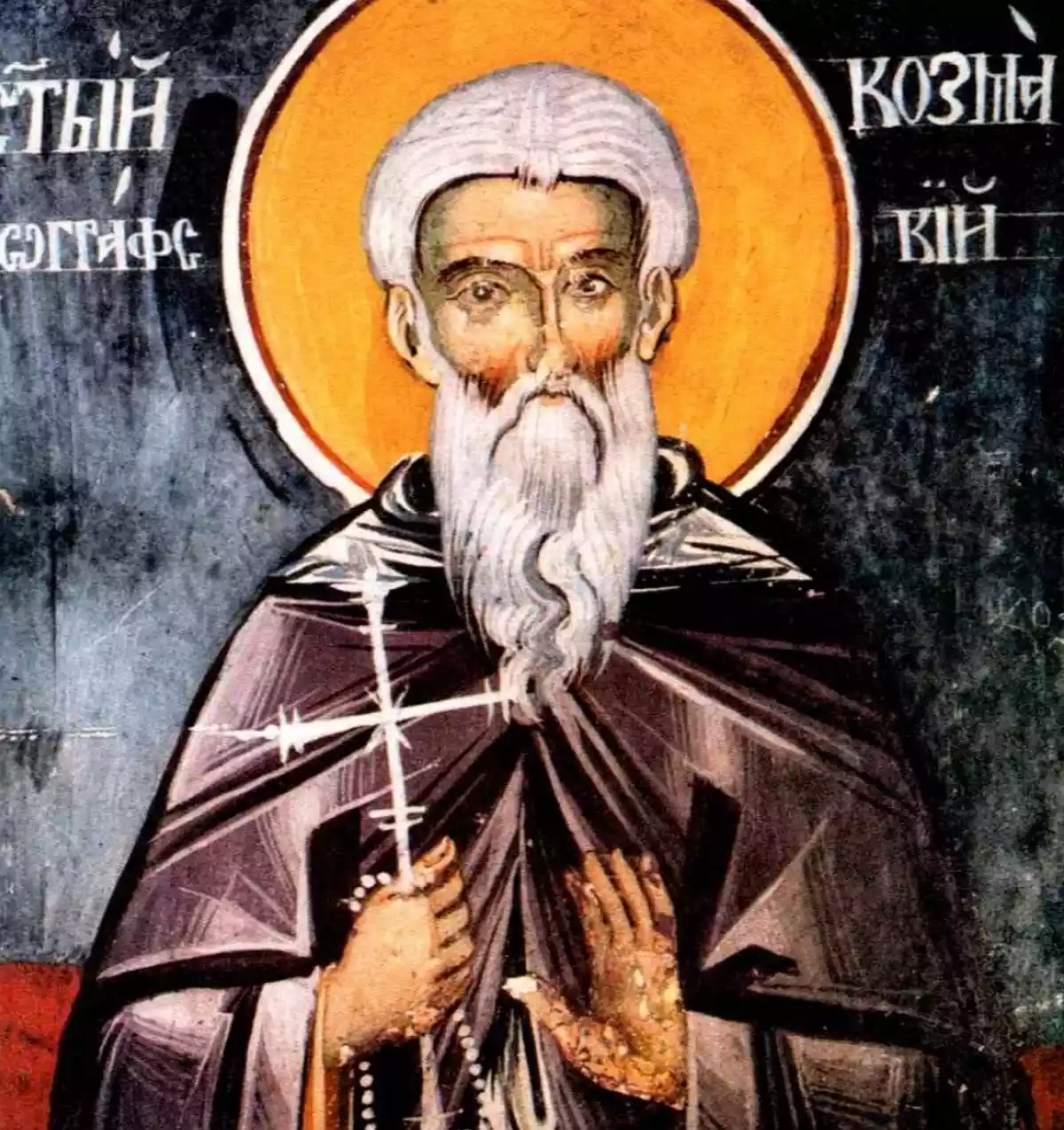
Saint Cosmas the Zographite was a prominent figure of Athonite monasticism during the 13th-14th century. Born into a noble family in Bulgaria, he abandoned worldly life to embrace monasticism on Mount Athos. He entered the Monastery of Zographou, where he distinguished himself for his virtue and spirituality. Later, he withdrew to the desert, where he lived as an ascetic and gained a reputation as a miracle worker. Saint Cosmas passed away peacefully on September 22, 1323, leaving behind a rich spiritual legacy. His memory is honored every year on September 22.
1. Life and deeds of Saint Cosmas
The life of Saint Cosmas the Zographite is a brilliant example of devotion to monastic life and spiritual upliftment. His life, filled with wondrous events and spiritual experiences, has inspired generations of believers and monks.
1.1 Origin and early years
Saint Cosmas was born at a time when Bulgaria was experiencing a period of cultural and spiritual flourishing. Coming from an aristocratic family, he had the privilege of an excellent education. His intelligence and love of learning led him to study both Greek and Bulgarian letters, a fact that would later prove invaluable in his spiritual journey.
However, despite the privileges of his social status, the young Cosmas showed a deep inclination towards spiritual matters from an early age. His parents, following the conventions of the time, sought to marry him off. This prospect, however, was contrary to his inner quests and his desire for a life dedicated to God.
In an act that would define the rest of his life, Cosmas decided to secretly leave his parental home. This decision was not merely an act of disobedience but a profound spiritual choice. Defying social expectations and material goods, the young Cosmas turned his gaze towards Mount Athos, the famous place of asceticism and spirituality.
1.2 Entry into monastic life
Cosmas’s arrival at Mount Athos marked the beginning of a new life. Mount Athos, with its rich monastic tradition, offered the ideal environment for a young man seeking spiritual perfection. His choice to enter the Monastery of Zographou was not accidental. This monastery, known for its spirituality and strict adherence to monastic rules, provided the appropriate framework for his spiritual development.
The transition from worldly life to monasticism was not an easy task. Cosmas had to adapt to a completely different way of life, full of prayer, fasting, and hard work. However, his dedication and spiritual strength helped him quickly overcome the initial difficulties.
After a period of trial, Cosmas received the monastic habit. This ceremony marked his definitive dedication to monastic life. As a new monk, he took on the duty of ecclesiastic, a service that required deep knowledge of liturgical order and sacred texts.
His spiritual progress did not go unnoticed. At a feast in the Monastery of Vatopedi, Cosmas had an experience that would forever change his spiritual path. He saw, according to tradition, the Theotokos herself serving the monks. This vision further strengthened his faith and inspired him to deepen his spiritual practice.
Cosmas’s virtue and dedication did not go unnoticed by the abbot of the monastery. Recognizing his spiritual gifts, the abbot intended him for the priestly office. However, Cosmas, with humility, sought guidance through prayer. According to tradition, the Theotokos indicated to him the path to the desert, where he could fully dedicate himself to his spiritual practice.
1.3 Ascetic life and spiritual gifts
Saint Cosmas’s transition to eremitic life was a milestone in his spiritual journey. He settled in an isolated cave near the Monastery of Zographou, which became the place of his rigorous asceticism and spiritual struggles. This cave, which survives to this day, witnessed his prayers, fasts, and spiritual battles with demons.
The fame of Cosmas’s holiness soon spread beyond the boundaries of Mount Athos. Many believers and monks began to visit him, seeking spiritual guidance and comfort. The Saint, with his gentleness and wisdom, became a spiritual father to many, offering advice and confessing those who came to him.
As his spiritual maturity increased, Cosmas was granted special gifts. He acquired the gift of foresight, being able to discern future events and read the hearts of people. Additionally, he was given the grace of performing miracles, healing the sick and offering relief to the suffering.
One of the most remarkable gifts of the Saint was his ability to experience divine visions. These mystical experiences brought him into direct contact with the divine, strengthening his faith and offering him a deeper understanding of spiritual truths.
As the end of his earthly life approached, Saint Cosmas was granted the knowledge of the day of his repose in advance. This knowledge, instead of frightening him, filled him with joy and anticipation for his union with the Lord. On September 22, 1323, Saint Cosmas peacefully surrendered his spirit to God.
The repose of the Saint was accompanied by a remarkable miracle that confirmed his holiness. According to tradition, during the funeral service, the wild beasts of the desert gathered around his body, paying tribute to the man of God. After his burial, each animal expressed its sorrow in its own way before returning to the desert.
The life and repose of Saint Cosmas the Zographite bear witness to the power of faith and dedication to spiritual life. His legacy continues to inspire and guide the faithful, reminding us of the possibility of spiritual elevation through humility, prayer, and love for God.
2. The legacy of Cosmas the Zographite
The life and work of Saint Cosmas left an indelible mark on the Athonite tradition. His spiritual legacy continues to inspire and guide the faithful, centuries after his repose.
2.1 Miracles and visions
The miracles attributed to Saint Cosmas are an integral part of hagiological tradition. His reputation as a miracle worker spread rapidly, attracting crowds of believers seeking healing and spiritual guidance.
One of the most remarkable miracles occurred when a blind pilgrim visited the Saint’s cell. The man, desperate about his condition, pleaded with Cosmas for help. The Saint, moved by the man’s faith, prayed fervently and anointed his eyes with holy oil. To everyone’s surprise, the man immediately regained his sight, glorifying God for the miracle.
The visions of Saint Cosmas were a source of inspiration and guidance not only for himself but also for those who visited him. In one instance, a young monk, tormented by doubts about his calling, sought the Saint’s advice. Cosmas, through a vision, saw the young man’s future spiritual struggle and guided him with wisdom, strengthening his faith.
The Saint’s ability to discern the thoughts and feelings of people was particularly impressive. Many testified that Cosmas could “read” their hearts, revealing hidden sins and offering guidance for repentance and spiritual upliftment.
2.2 The repose and the miracle of the beasts
The repose of Saint Cosmas, on September 22, 1323, was marked by a remarkable event that confirmed his holiness. As the monks gathered to perform the funeral service, an unusual spectacle unfolded before their astonished eyes.
From the depths of the desert, wild animals began to flock to the spot where the Saint’s body lay. Wolves, bears, lions, and other beasts, which under normal circumstances would be hostile to each other, gathered peacefully around the relic. The sight was so impressive that the attending monks were left speechless, recognizing in it a divine sign.
As the service progressed, the animals remained quiet, as if participating in the mourning. After the Saint’s burial, something even more remarkable happened. Each animal, in its own unique way, expressed its sorrow. The wolves howled to the sky, the bears growled deeply, and the birds sang melodiously. It was as if the entire nature was bidding farewell to a holy man.
This event, known as “the miracle of the beasts,” was a powerful testimony to Cosmas’s holiness. It reminded everyone of the harmonious relationship between man and nature that existed in Paradise, which the Saint had managed to regain through his holiness.
2.3 Saint Cosmas the Zographite and his influence on Athonite monasticism
The influence of Saint Cosmas on Athonite monasticism was profound and long-lasting. His life became a model of asceticism and spiritual perfection for generations of monks who followed.
The Saint’s cell, the steep cave near the Monastery of Zographou, became a place of pilgrimage. Many monks sought to practice asceticism there, hoping to experience even a part of the Saint’s spiritual experience. Tradition states that those who stayed in Cosmas’s cell felt a special spiritual presence, as if the Saint continued to guide and inspire.
The Saint’s teaching on mental prayer and heart quietness deeply influenced Athonite spirituality. The methods of exercise and prayer he developed were incorporated into the daily practice of many monks. The emphasis he placed on inner silence and unceasing prayer became a central element of Athonite tradition.
The fame of Saint Cosmas spread beyond the boundaries of Mount Athos. Many laypeople, inspired by his life, sought ways to apply his teachings in their daily lives. This led to the development of a more internal and personal approach to faith, even for those living in the world.
The legacy of Saint Cosmas continues to live through the writings and teachings attributed to him. Although he did not leave written works, his students and spiritual descendants recorded his teachings and sayings. These texts are a valuable source of spiritual guidance for monks and laypeople to this day.
The figure of Saint Cosmas remains alive in the collective memory of Mount Athos. Every year, on the day of his memory, crowds of pilgrims flock to the Monastery of Zographou to honor the holy ascetic. The service held in his honor is a reminder of the timeless value of his spiritual legacy.
The life and work of Saint Cosmas the Zographite are a lasting source of inspiration and spiritual guidance. His dedication to ascetic life, his love for God and fellow man, and his deep humility remain shining examples for those seeking a deeper spiritual life.
Epilogue
Saint Cosmas the Zographite emerges as an emblematic figure of Athonite monasticism. His life, characterized by deep spirituality and asceticism, is a model of virtue and dedication. His miracles and teachings have left an indelible mark on Orthodox tradition. His influence extends beyond Mount Athos, inspiring believers through the ages. The legacy of Saint Cosmas remains alive, reminding us of the power of faith and humility in the spiritual upliftment of man.
elpedia.gr

